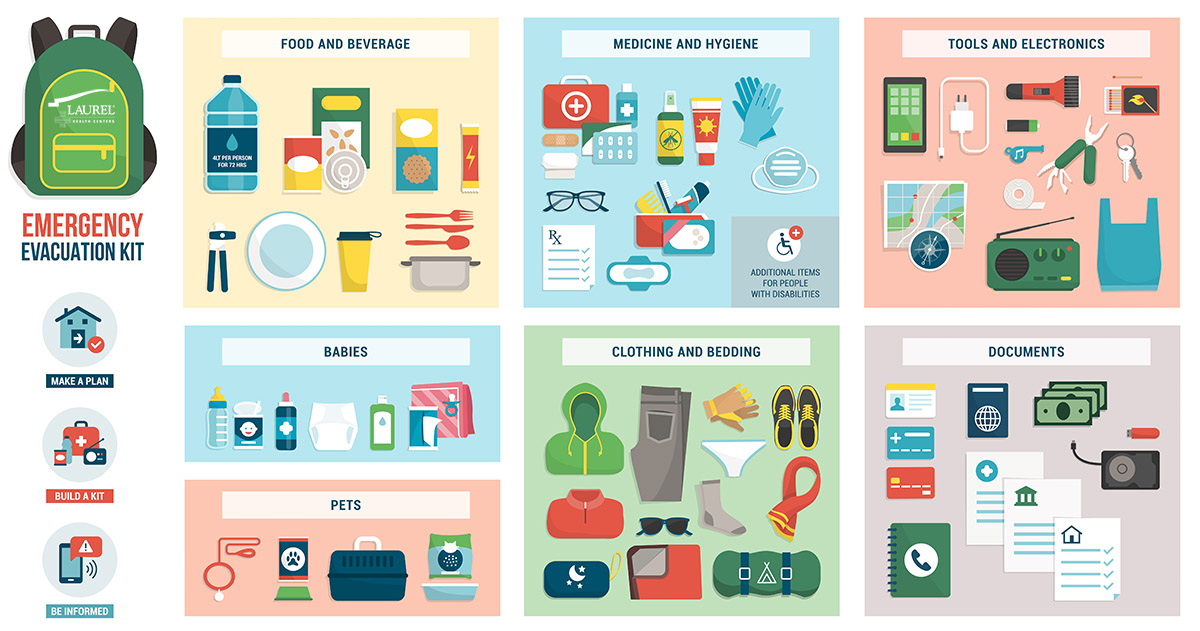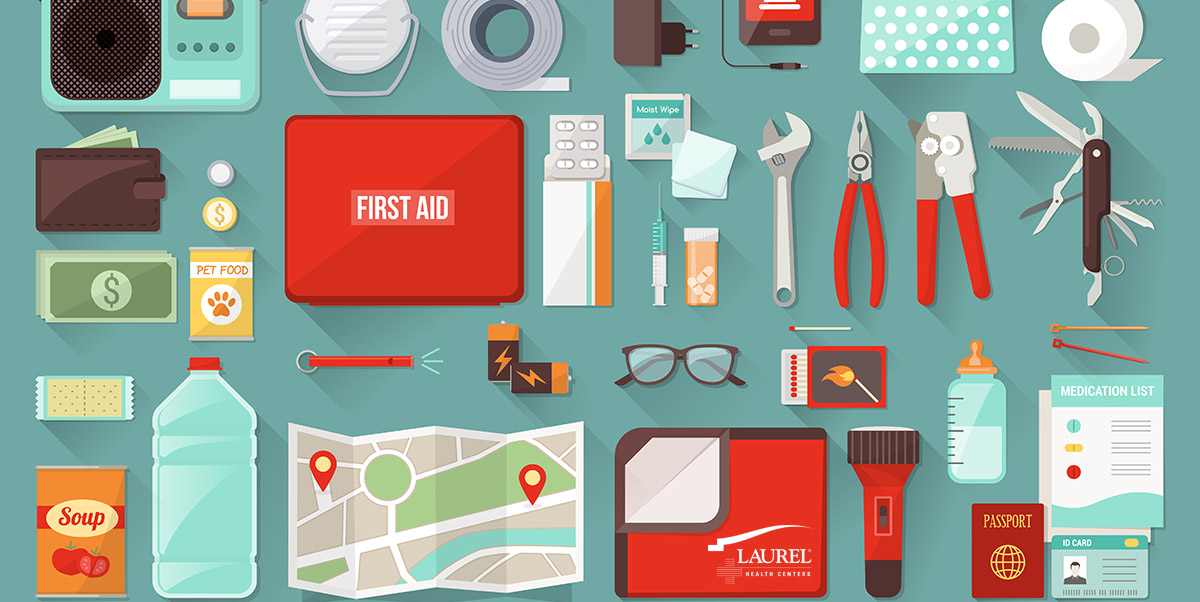By Kristy Warren
When disaster strikes, does your family have a plan? Thinking about emergencies can be uncomfortable, but planning ahead allows you to prepare thoroughly for a stressful or scary situation when you are calm and safe. Having a guide for how to handle emergency situations can empower you to focus, stay collected, and react faster during an actual emergency.
The Laurel Health Centers encourage everyone to develop their own emergency preparedness plans by laying out detailed steps and tools for handling different types of emergencies, such as medical emergencies, active shooters, and natural disasters like floods, fires, extreme heat, blizzards, and tornadoes.
DON'T PANIC, BUT TAKE EMERGENCY PLANNING SERIOUSLY
While we all hope we won’t have to use it, having a plan in place to deal with a worst-case scenario and the tools you need to tackle it allows you to stay calm, react faster, and exert some control over an uncertain situation while minimizing disruption to your daily routine.
Another important component of emergency planning is making sure everyone in your household, workplace, or school is on the same page about what to do during different types of emergencies, where to locate needed supplies / tools, and how to properly use those tools.
EMERGENCY PLANNING CHECKLIST
Building a comprehensive preparedness plan all at once can feel daunting. Break up your emergency planning into stages so you can collect information, discuss with family and friends, and assemble supplies.
- Make a list of the types of emergencies that are more likely to happen in your area. While it is important to prepare for the unexpected, it is wise to know and train for handling the types of emergencies most common where you live.
Questions to ask: What are the most likely emergencies or threats where I live? How can I mitigate those risks? For example, if you live in an area prone to wildfires, extreme heat, drought, flooding, or heavy snowstorms, make sure to include contingency plans for those types of events addressing how you'll respond to those conditions.
- Familiarize yourself with your region's alert systems, warnings, and official sources of emergency information.
Questions to ask: Does your area have warning sirens? Can you sign up for a county or statewide emergency warning system to notify you of public health emergencies, threats, or natural disasters? Do you have a battery-powered weather radio to receive updates on severe weather during a power outage?
- If you live with others, sit down with your family, friends, and roommates to discuss your home's evacuation plan, emergency supplies, and everyone's role during an emergency.
Questions to ask: Do your children know what to do during different types of emergencies (e.g., the fire escape routes and how to check exits for safety)? Who is in charge of stocking the emergency kit and assuring perishable items are in date? Does everyone know how to use the fire extinguisher correctly? If schools or daycare facilities must temporarily close but you're unable to stay home with them, who will take care of your children?
- Talk about what needs to be included in your emergency kit. Food, fresh water, clothing, tools like can openers, bandages, antiseptic, and bedding are emergency kit staples, but don't forget about your family's unique needs. For example, don't forget pet food, leashes, and carriers if you have animals. If someone has less mobility or chronic conditions like asthma, heart disease, and diabetes, they may require additional tools, medicine, and accommodations.
Questions to ask: How much food and water do you and your family / pets need each day? What medications do you need daily? How much medication should you have on hand in the event of a supply chain disruption (ask your doctor)? Does every member of your household know where your emergency kit is located and how to use what's in it? Do you have a kit for your car in case you're stranded during travel?
As we witnessed during the worst months of the Coronavirus COVID-19 pandemic and recent natural disasters, a large influx of people in need of care and resources can overwhelm healthcare facilities and create a ripple effect that disrupts transportation, education, the workforce, economy, and food supply chain. A personal preparedness plan can help you and your loved ones better navigate this ripple effect and respond to rapidly changing conditions.
PLAN FOR THE WORST, HOPE FOR THE BEST
The Laurel Health Centers are well-prepared to tackle healthcare emergencies. We train extensively every year on how best to respond quickly and effectively to care for our community through pandemics, natural disasters, and other emergencies.
Laurel Health's thorough emergency response plan allows us to pivot quickly and effectively—and a personal emergency preparedness plan helps you and your family do the same.
The more contingencies you can think through now when you are calm and have ample time to plan, the better prepared you’ll feel and the faster you can respond in a stressful situation.

MAKING YOUR OWN EMERGENCY PREPAREDNESS PLAN
Step 1: Write a detailed emergency plan. Think through the roles each family member would play during an emergency and how you would communicate with each other, extended family, friends, school, and work.
If you have young children, elderly family, or pets, outline your backup plan for their care. To jumpstart your planning, imagine scenarios that could disrupt your routine and ask yourself hypothetical questions you'd need to address in your plan like "what happens if I'm held up at work and can't pick up my child? Who will take care of my kids while I'm at work if the babysitter is unavailable or school / daycare must close?"
Walk through your plans together for common types of emergencies like fires, severe weather, natural disasters, or illness. Make sure everyone understands what to do. Consider making an out-of-state friend one of your family contacts, as calling locally during an emergency like a weather disaster is sometimes impossible. Learn your community’s warning signals (e.g., tornado sirens, Swift911 county alerts) and what you should do if you receive them. Include those details in your personal plan.

Step 2: Assemble an emergency response kit. Your kit should include the supplies you need to tackle multiple types of emergencies. When creating your kit, make sure to account for the size of your family to ensure you have enough for everyone.
Your emergency kit should include medical supplies, non-perishable food, fresh water, prescriptions, important medical information for first responders listing your allergies, care plans, and medications, lists of emergency contacts, pet food, copies of important documents like IDs, and utility supplies like flashlights with extra batteries, emergency blankets, and weather radios.
A good rule is to make sure you have at least one gallon of water per person per day for a week and an emergency kit with enough antiseptic, sterile wipes, bandages, and medication to tend the injuries of multiple people. For help with building your kit, visit ready.gov or health.pa.gov.
Step 3: Stay informed and keep your materials up-to-date. Once you build your emergency kit, keep it updated with the most current actions, information, supplies, and contacts.
Periodically go through your kit to check for dead batteries and make sure to replace any expired items. Update your response plan to reflect changing roles, as your child will have a different role in your family’s emergency plan at age 8 than they will at 16. Be sure to reflect changes to family dynamics, too, like moving into a new home with a different fire escape plan or having a child away at college.
Remember, it's natural to feel uncomfortable planning for an emergency, but your future self will thank you!
For more tips on keeping your family safe and healthy, stay tuned to the Laurel Health Centers' news page or visit us on Facebook at facebook.com/laurelhc.
